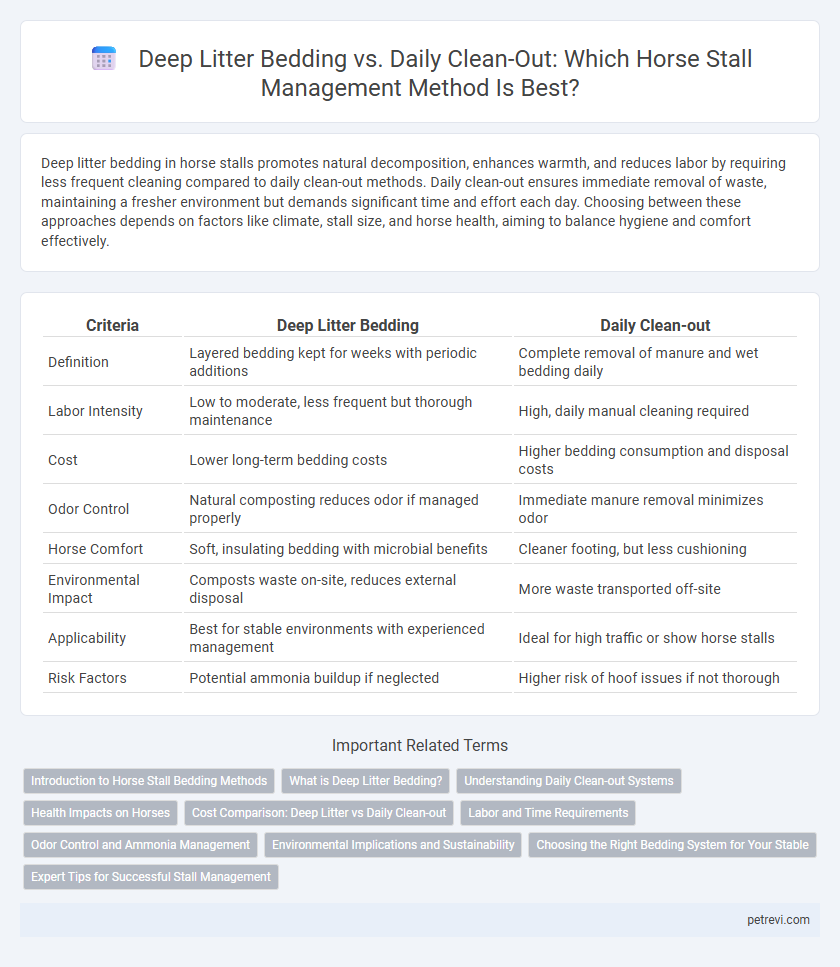Deep litter bedding in horse stalls promotes natural decomposition, enhances warmth, and reduces labor by requiring less frequent cleaning compared to daily clean-out methods. Daily clean-out ensures immediate removal of waste, maintaining a fresher environment but demands significant time and effort each day. Choosing between these approaches depends on factors like climate, stall size, and horse health, aiming to balance hygiene and comfort effectively.
Table of Comparison
| Criteria | Deep Litter Bedding | Daily Clean-out |
|---|---|---|
| Definition | Layered bedding kept for weeks with periodic additions | Complete removal of manure and wet bedding daily |
| Labor Intensity | Low to moderate, less frequent but thorough maintenance | High, daily manual cleaning required |
| Cost | Lower long-term bedding costs | Higher bedding consumption and disposal costs |
| Odor Control | Natural composting reduces odor if managed properly | Immediate manure removal minimizes odor |
| Horse Comfort | Soft, insulating bedding with microbial benefits | Cleaner footing, but less cushioning |
| Environmental Impact | Composts waste on-site, reduces external disposal | More waste transported off-site |
| Applicability | Best for stable environments with experienced management | Ideal for high traffic or show horse stalls |
| Risk Factors | Potential ammonia buildup if neglected | Higher risk of hoof issues if not thorough |
Introduction to Horse Stall Bedding Methods
Deep litter bedding involves layering organic materials such as straw or wood shavings that decompose gradually, creating a natural composting environment that reduces odor and promotes microbial health. Daily clean-out requires removing soiled bedding and manure every day, maintaining a consistently clean and dry stall to minimize ammonia buildup and reduce the risk of respiratory issues. Both methods aim to provide comfort, hygiene, and hoof health benefits for horses while balancing labor, cost, and environmental impact.
What is Deep Litter Bedding?
Deep litter bedding is a stall management technique that involves layering organic materials such as straw, wood shavings, or sawdust and allowing them to decompose gradually over time, creating a composting effect. This method helps maintain manure and moisture control by promoting microbial activity that breaks down waste, reducing odors and the need for frequent clean-outs. Deep litter bedding supports a healthier environment for horses by providing better insulation, improved hoof health, and enhanced ammonia absorption compared to daily clean-out practices.
Understanding Daily Clean-out Systems
Daily clean-out systems in horse stall management involve removing soiled bedding and manure every day to maintain optimal hygiene and reduce ammonia buildup. This method minimizes the risk of respiratory issues and hoof problems by providing a consistently dry and clean environment for horses. Regular removal also helps in early detection of health concerns through daily monitoring of manure and urine patterns.
Health Impacts on Horses
Deep litter bedding promotes beneficial microbial activity that helps control ammonia levels, reducing respiratory issues in horses compared to daily clean-out methods. The gradual decomposition process in deep litter creates a warmer and drier environment, minimizing hoof infections and skin irritations. Conversely, frequent daily clean-outs may disrupt natural microbial balance, potentially increasing exposure to airborne dust and pathogens impacting equine respiratory health.
Cost Comparison: Deep Litter vs Daily Clean-out
Deep litter bedding reduces overall costs by minimizing the need for frequent bedding replacement and labor associated with daily clean-outs, while daily clean-outs incur higher expenses due to constant bedding purchase and increased labor hours. Deep litter systems utilize microbial activity to break down waste, lowering manure disposal fees and extending bedding life, leading to substantial savings on materials and labor over time. Daily clean-out methods require more frequent bedding replenishment and stall maintenance, resulting in increased operational costs for horse stall management.
Labor and Time Requirements
Deep litter bedding reduces labor and time requirements by allowing horse owners to clean stalls less frequently, often only needing to remove waste once a week instead of daily. This method minimizes physical effort and time spent, as fresh bedding is added over time, promoting composting of manure within the stall. In contrast, daily clean-out demands consistent, time-intensive labor to remove all waste and replace bedding, significantly increasing daily maintenance efforts.
Odor Control and Ammonia Management
Deep litter bedding in horse stalls offers superior odor control by promoting microbial decomposition of waste, which significantly reduces ammonia buildup compared to daily clean-out methods. This natural composting process maintains a stable, low-ammonia environment that enhances respiratory health for horses. In contrast, daily clean-outs, while removing waste frequently, may not prevent ammonia from accumulating between cleanings, potentially increasing odor and respiratory risks.
Environmental Implications and Sustainability
Deep litter bedding in horse stall management significantly reduces waste output by allowing manure and bedding to decompose naturally, promoting nutrient recycling and lowering landfill contributions. This method enhances microbial activity that breaks down organic material, reducing the frequency of stall cleaning and water use compared to daily clean-out practices. Conversely, daily clean-outs lead to higher water consumption, increased waste disposal needs, and potentially greater environmental impact due to the frequent removal and transport of fresh manure and bedding materials.
Choosing the Right Bedding System for Your Stable
Deep litter bedding provides superior moisture absorption and natural composting benefits, reducing waste removal frequency and promoting a healthier stable environment. Daily clean-out systems offer immediate cleanliness and hygiene control but demand more labor and time commitments to maintain stall dryness and reduce ammonia buildup. Evaluating stable size, horse density, and maintenance resources is crucial for selecting an effective bedding strategy that optimizes horse health and stable management efficiency.
Expert Tips for Successful Stall Management
Deep litter bedding offers superior moisture control and natural composting benefits, promoting healthier stall environments with reduced ammonia levels. Experts recommend maintaining a consistent layering technique and monitoring moisture to prevent odor and pathogen buildup. Conversely, daily clean-out ensures immediate waste removal but requires more labor and attention to prevent dampness that can compromise hoof health.
Deep Litter Bedding vs Daily Clean-out for Horse Stall Management Infographic

 petrevi.com
petrevi.com